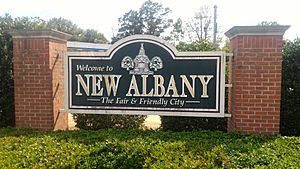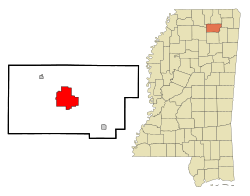New Albany, Mississippi facts for kids
Quick facts for kids
New Albany, Mississippi
|
|
|---|---|
 |
|
| Nickname(s):
"The Fair and Friendly City"
|
|

Location of New Albany, Mississippi
|
|
| Country | United States |
| State | Mississippi |
| County | Union |
| Area | |
| • Total | 18.28 sq mi (47.35 km2) |
| • Land | 18.23 sq mi (47.22 km2) |
| • Water | 0.05 sq mi (0.13 km2) |
| Elevation | 345 ft (105 m) |
| Population
(2020)
|
|
| • Total | 7,626 |
| • Density | 418.25/sq mi (161.49/km2) |
| Time zone | UTC-6 (Central (CST)) |
| • Summer (DST) | UTC-5 (CDT) |
| ZIP code |
38652
|
| Area code(s) | 662 |
| FIPS code | 28-51000 |
| GNIS feature ID | 2404357 |
New Albany is a city in Mississippi, United States. It is the main town and county seat of Union County. In 2020, about 7,626 people lived there.
Contents
Discovering New Albany's Past
New Albany started in 1840. It was built where a grist mill (for grinding grain) and a sawmill (for cutting wood) were located. This spot was on the Tallahatchie River, near where two Chickasaw trade paths crossed. The town grew as a busy river port and a center for farming and business.
New Albany During the Civil War
During the American Civil War, soldiers from the United States Cavalry rode through New Albany. They were led by Benjamin Grierson. Their mission was to attack Vicksburg. In New Albany, they met Confederate soldiers who were trying to destroy a bridge over the Tallahatchie River. The Confederate troops ran away, and the bridge was saved.
Growth and Railroads
Union County was created in 1870. New Albany became its county seat. In the late 1880s, two railroads came to New Albany. These were the Kansas City, Memphis and Birmingham Railroad and the Gulf and Ship Island Railroad. This happened around the time the town's 600 residents were rebuilding after a big fire.
In 2013, a part of the old railroad was turned into a paved path called the Tanglefoot Trail. This trail follows the route of a railway that was once operated by the grandfather of famous author William Faulkner.
New Albany's Location and Size
New Albany covers about 17.1 square miles (47.35 square kilometers). Most of this area is land, with a small part being water.
New Albany's Population
New Albany has grown a lot since it was founded. Here's how its population has changed over the years:
| Historical population | |||
|---|---|---|---|
| Census | Pop. | %± | |
| 1880 | 250 | — | |
| 1890 | 548 | 119.2% | |
| 1900 | 1,033 | 88.5% | |
| 1910 | 2,032 | 96.7% | |
| 1920 | 2,531 | 24.6% | |
| 1930 | 3,187 | 25.9% | |
| 1940 | 3,602 | 13.0% | |
| 1950 | 3,680 | 2.2% | |
| 1960 | 5,151 | 40.0% | |
| 1970 | 6,426 | 24.8% | |
| 1980 | 7,072 | 10.1% | |
| 1990 | 6,775 | −4.2% | |
| 2000 | 7,607 | 12.3% | |
| 2010 | 8,034 | 5.6% | |
| 2020 | 7,626 | −5.1% | |
| U.S. Decennial Census | |||
People in New Albany (2020)
In 2020, there were 7,626 people living in New Albany. They lived in 2,971 households, with 1,911 being families.
Here's a look at the different groups of people living in New Albany in 2020:
| Race | Number of People | Percentage |
|---|---|---|
| White | 4,319 | 56.64% |
| Black or African American | 2,229 | 29.23% |
| Native American | 11 | 0.14% |
| Asian | 69 | 0.9% |
| Other/Mixed Race | 276 | 3.62% |
| Hispanic or Latino | 722 | 9.47% |
Learning in New Albany
New Albany has a long history with its schools. For many years, schools were separate for White and Black students. In 1901, the first public school building with 18 classrooms was built. The only high school for Black students in Union County was Union County Training School, founded in 1812. This school, like others for African-American students, did not get money from the government.
School Integration and Today
In 1964, the school system slowly began to integrate, meaning students of all races could attend the same schools. This process finished in 1970. Today, most of New Albany is served by the New Albany School District. Some small parts are in the Union County School District.
New Albany also has a branch campus of Northeast Mississippi Community College.
Sports Achievements
The New Albany High School Bulldogs boys basketball team won state championships three years in a row: 1985, 1986, and 1987. Former NBA player John Stroud coached the team in 1987.
Getting Around New Albany
New Albany has several important roads and trails that help people travel.
Major Roads
Interstate 22 (also known as US Highway 78) runs right through New Albany. Mississippi Highway 15 connects New Albany to Ripley in the north and Pontotoc in the south. Mississippi Highway 30 links New Albany to Oxford to the west and Booneville to the northeast.
Railroads and Trails
New Albany is served by the BNSF Railway and the Ripley and New Albany Railroad. These two railroads cross paths in the downtown area.
A special part of the old railway has been paved to create the Tanglefoot Trail. This is the longest "rail-trail" in Mississippi, perfect for walking, running, and biking. New Albany is the starting point for the northern end of this trail.
Famous People from New Albany
Many interesting people have come from New Albany, including:
- Bob Boyd, a baseball player
- William Faulkner, a famous author who won the Nobel Prize
- Marcus Green, a football player
- John Stroud, a basketball player and coach
- Eli Whiteside, a baseball catcher and coach for the San Francisco Giants
- Bettie Wilson, a woman who lived to be 115 years old
See also
 In Spanish: New Albany (Misisipi) para niños
In Spanish: New Albany (Misisipi) para niños


